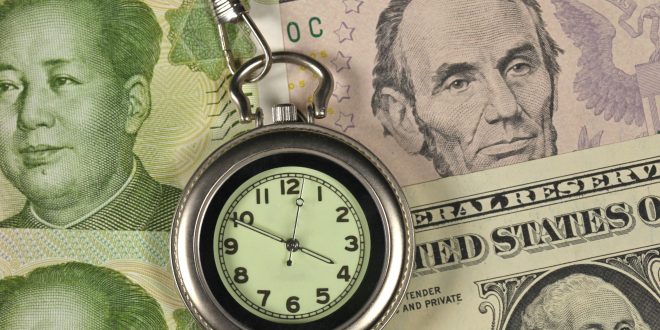The FOMC remained in dovish mode, despite promising US numbers. The UK economy is gradually reopening, but the eurozone is still hampered by a slow vaccine rollout. Here are the most prominent events and data affecting the markets over the past week
U.S. dollar and Currencies
The Bank of Canada indicated the previous week that it may raise interest rates in late 2022 while slowing the pace of bond purchases. The US dollar closed higher last week with most of its gains achieved on Friday and that rally was due to profit-taking at the end of the month, but Treasury yields rose last week, exceeding expectations and there may be more moves.
The Fed was, as expected, pessimistic, but this is nothing new as Fed Chairman Jerome Powell and his colleagues have been telegraphing this out in months, however, markets blamed the central bank’s policy.
the US dollar rose on Friday, extending its gains after optimistic data on the income and spending of US consumers and the manufacturing sector in the Midwest states. But the dollar index ends April down 2.1%, its biggest loss in one month since December.
The euro fell 0.8% against the US currency to $1.2018, its biggest one-day drop in terms of percentage since late February, but ends the month with a gain of 2.5%, its best monthly performance since July 2020.
The dollar rose against the Japanese currency 0.36% to 109.30 yen, posting a 1% gain over the week. But it ended the month down 1.3%, its worst monthly performance since July 2020.
By the end of the week, the US dollar index settled at 91.270, up by 0.47%.
Looking at the components of the US dollar index, the euro recorded losses by 0.63%, the British pound fell by 0.51%, while the Japanese yen closed down 1.35%, the Canadian dollar rose 1.46% and the Swiss franc by 0.07%.
The euro fell sharply on Friday, wiping out all its weekly gains, just one day after it reached its highest level since February 26. Reuters reported that the euro-zone economy has entered a second technical recession after a less-than-expected contraction in Q1, but is now poised to recover strongly with the lifting of restrictions and accelerated vaccination campaigns.
The pound also erased its weekly gains on Friday as investors dumped the pound ahead of next week’s BoE monetary policy meeting, but few analysts expect changes to the BoE policy statement on Thursday and some believe the central bank may slow down bond purchases.
The Japanese Yen was weak against the US dollar throughout the week as investors welcomed the domestic retail sales data and the Fed held its pessimistic stance.
Stocks
Wall Street closed lower on Friday the S&P 500 and Nasdaq indices were affected by losses in Apple, Alphabet, and other technology-related companies despite strong quarterly earnings reports.
The S&P 500 ended the week, up 0.03%, while the DowJones and the Nasdaq slipped 0.48% and 0.39%, respectively.
The three indices ended the month in gains, with the S&P 500 climbing 5.24%, DowJones up 2.72% and the Nasdaq up 5.40%.
Oil
At a time when oil prices were affected by the Indian strain of the Coronavirus at the end of April, global demand for oil has almost returned to pre-pandemic levels, supported by economic stimulus plans in America and the easing of closures and lockdowns in some countries of the world.
Thus, oil prices recorded their fifth rise in last April within six months, as Brent crude and US crude achieved monthly gains close to about 6% and 7.5%.
On the other hand, the two crude oil prices recorded their biggest daily decline in more than three weeks, with the decline in oil demand in India due to the pandemic crisis that is ravaging the country.
Brent contracts ended the April 30 session down $1.29, or 1.9%, on the last trading day for June delivery, and US crude for June delivery fell $1.43, or 2.2%.
According to analysts, the global demand for fuel around the world is in contrast with the rise in consumption in the United States and China, at a time when other countries resume closures to stop the increasing number of Corona cases.
While oil prices were under pressure due to fears of re-imposing wider restrictions in India and Brazil to limit the spread of the Coronavirus.
On the other hand, a Reuters survey concluded that OPEC oil production rose in April, as the increase in Iranian supply overshadowed the voluntary cuts and reductions agreed upon among the rest of the members as part of an agreement with allies, which increases indications of a recovery in Tehran’s exports in 2021.
The survey concluded that the 13-member Petroleum Exporting Organization pumped 25.17 million barrels per day in April, up 100,000 barrels per day from March. Production has been increasing every month since June 2020, with the exception of February.
Fed
The Federal Open Market Committee (FOMC) decided to keep the benchmark interest rate at historically low levels of 0.25% while maintaining the asset purchase program at $120 billion, $ 80 billion for US Treasury bonds, and 40 billion for mortgage-backed securities.
The Federal Reserve stated that it will hold the key rate at 0.25% and pledged to use all tools to support and strengthen the US economy as it seeks to revive the labor market and stabilize markets. The bank stated that it would keep inflation below the 2% target.
“Fed will continue to increase bond purchases by at least $80 billion/month of treasuries and $40 billion/month of MBS until substantial further progress made on maximum employment and price stability goals.”
“Will maintain current fed funds rate until labor market has reached maximum employment and inflation has risen to 2% and is on track to moderately exceed that for some time.” Statement read.
Calendar
The United States’ Real Gross Domestic Product (GDP) expanded at an annual rate of 6.4% in the first quarter of 2021, the US Bureau of Economic Analysis first estimate showed on Thursday. This reading followed the 4.3% growth of the fourth quarter and came in slightly better than the market expectation of 6.1%.
The US consumer confidence index improved to 88.3 in April from 84.9% in March, the latest consumer opinion polls at the University of Michigan showed on Friday. The reading comes in better than market expectations of 87.5 and 86.5.
As for the economic conditions index, it improved to 97.2 from 93, and the consumer expectations index rose to 82.7 from 79.7. the 1-year Inflation Outlook increased to 3.4% from 3.1%.
The US Bureau of Economic Analysis reported on Friday that Personal Income in March rose by 21.1% fueled by stimulus checks. This reading came in better than the market expectation for an increase of 20.3% and followed February’s contraction of 7%.
The publication revealed that Personal Spending increased by 4.2% in the same period, compared to analysts’ estimate of 4.1%.
Inflation in the US, as measured by the PCE price index, rose to 0.5% in March from 0.2% in February, the market had expected to come in at 0.3. On a yearly basis, the PCE price index jumped to 2.3% from 1.5%.
Canada’s Real Gross Domestic Product (GDP) expanded at a monthly rate of 0.4% in February, the data published by Statistics Canada showed on Wednesday. This reading came in slightly weaker than the market expectation for a growth of 0.5%.
Retail Sales in Canada rose by 4.8% on a monthly basis in February, the data published by Statistics Canada revealed on Wednesday. This reading followed January’s contraction of 1.1% and came in better than the market expectation for an increase of 4%.
the German economy shrank 1.7% inter-quarter in Q1 of 2021 when compared to the expectations of -1.5% and +0.3% seen in Q4, the preliminary report published by Destatis showed on Friday.
Meanwhile, the annualized GDP rate fell by 3% in Q1 against the previous reading of -3.7% and beat market expectations of -3.2% contraction.
Separately, the Italian economy contracted by 0.4% QoQ in Q1 but bettered estimates of -0.5% and -1.8% previous.
The Eurozone economy contracted 0.6% on quarter in the three months to March of 2021, beating -0.8% expected and -0.7% prior, the first estimate showed on Friday.
On an annualized basis, the bloc’s GDP rate dropped by 1.8% in Q1 vs. -4.9% booked in the final quarter of 2020 while beating -2% expectations.
Eurozone’s unemployment rate arrived at 8.1% in March when compared to February’s 8.3%.
The German economy shrank 1.7% inter-quarter in the first quarter of 2021 when compared to the expectations of -1.5% and +0.3% seen in Q4, the preliminary report published by Destatis showed on Friday.
Meanwhile, the annualized GDP rate fell by 3% in Q1 against the previous reading of -3.7% and beat market expectations of -3.2% contraction.
Cryptocurrencies
Ethereum outperformed its Bitcoin counterpart last week, with Ethereum recording its highest level ever at $ 2,713, during Wednesday’s trading.
Ethereum reached an all-time high due to news that the European Investment Bank in Luxembourg had chosen to issue a two-year bond worth 100 million euros on the Ethereum blockchain.
Banking giants such as Goldman Sachs and Cité General will manage the issuance of the bonds for two years.
In another context, Goldman Sachs recently announced that it plans to make an offer for its wealthy clients to invest in Bitcoin.
Metals
Palladium broke the $ 3,000 an ounce barrier for the first time on Friday, April 30, spurred by persistent concerns over a supply shortage of the metal used primarily in the automotive industry’s emission controls.
Palladium was in the latest trading, up 1% to $ 2984.68 an ounce, after reaching its highest level ever at $ 3007.73. it is on his way to post a monthly profit as well.
Demand from the auto industry is on the rise and is expected to rise further, as it is set to subside later this year. A shortage of semiconductor chips has caused car production to shrink.
Coronavirus
Britain recorded 1671 new cases of coronavirus, and 14 deaths.
Today, the Ministry of Health data showed that Turkey recorded 340 deaths related to the Coronavirus and 25,980 new cases during the past twenty-four hours, which is the third day of general isolation in the country, which includes the imposition of a curfew and the closure of schools and many companies.
According to a Reuters count, Turkey ranks fourth in the world in terms of the number of daily cases, on an average of seven days, down from the second place it occupied for a short period last month.
After easing measures in early March, President Recep Tayyip Erdogan’s government reversed its decision after infections reached record levels.
Turkey recorded a record 394 virus-related deaths on Friday, although new infections have decreased since April 21.
India’s industrial authority has urged the authorities to take “the strongest national steps” and curtail economic activity to save lives, as the country grapples with the growing cases of coronavirus that have overwhelmed the health care system.
The rate of new cases decreased slightly, but deaths continued to rise.
Authorities reported 392,488 new cases in the past 24 hours, bringing the total to 19.56 million.
The number of deaths jumped to a record high of 3,689, bringing the total number to 215,542.
 Noor Trends News, Technical Analysis, Educational Tools and Recommendations
Noor Trends News, Technical Analysis, Educational Tools and Recommendations





